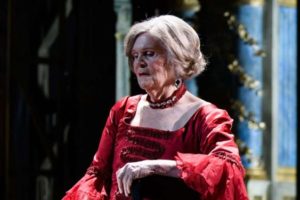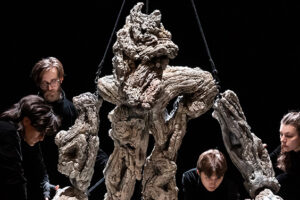

The argument over how nit-pickily critical an aficionado should be (hello, cher public!) misses the point, if slightly, since in every generation there will be a dearth of something or another. Yes, it’s all worth keeping track of and being smart about — and yet, each age also has its peculiar strengths, even if they’re not one’s preferred strengths. And so, mightn’t we admit, “sure, we may not be living in an era of big voices, but goddamn: isn’t there a gratifying amount of programming ingenuity coming from Lincoln Center right about now?”
Most everyone is, at this point, familiar with the Peter Gelb backlash, as well as the backlash to the backlash. But even Gelb’s boosters and detractors might agree on one point: composer diversity has fared well under his watch. Even in a down economic year, with the Corigliano opera canceled, he still provided us rare looks at Janacek and Shostakovich.
Across the plaza, George Steel has more to prove and less of a track record, though his first small City Opera season notched a proportional small success. His next run of offerings — boasting curiosities from the likes of Bernstein and Strauss, plus an evening of modernist monodramas — suggests that he understands something important about the proper scale of his company’s relationship to the house next door. The rivalry is only useful to New York’s musical life so long as it is engaged on the question of how best to go about being interesting, as opposed to questions of budget or glitz. Given last fall’s sexy, minimalist gloss on Don Giovanni (the premiere of which drew a sneaking-into-his-seat-at-the-last-second Mr. Gelb), it’s a competition Steel is showing he knows how to make compelling. Advantage: audiences.
And now Alan Gilbert is telling us he wants to be interesting in the field of opera, too. The musical director of the New York Philharmonic has programmed a bold first season by any definition: the likes of Ives and Beethoven—or Webern and Schumann—sit comfortably not only in the same subscription series, but in the same concerts. And now he’s somehow got it in his head that he can stage important local operatic premieres in Avery Fisher hall. Even five years ago, this may have seemed a ludicrous idea. But there’s now reason to believe that a full operatic meal might be served at Gilbert’s theater, even with an orchestra in full view. The recent renaissance of video projection as something other than a poor-cousin of traditional stagecraft is what makes this prospect more than a hope against hope.
Los Angeles Opera’s recent U.S. premiere of Franz Schreker’s Die Gezeichneten reportedly was brought in for a “low six figures” in part because video projections conjured so much of the work’s complex, dreamlike world. The shots below show how easily (and quickly) director Ian Judge and lighting designer Daniel Ordower were able to change settings without even dropping a curtain. Video art provided audiences with an exterior view of Alviano’s Elysium, his indoor study stuffed with treasured canvases, and Carlotta’s studio in Genoa, with only a few pieces of furniture needed in the foreground for each scene. (Photos courtesy of Los Angeles Opera.)
In April, I entered the theater wondering how well this extensive reliance on video would play. I left hugely encouraged about a more cost-effective, less real-time labor-intensive way for companies to perform riskier repertoire.
Gilbert sees video as the critical ingredient that may allow for the Philharmonic’s ability to present staged operas, without needing to lean on the prefix apology of “semi-” in the brochure. The first opera he has programmed, Ligeti’s Le Grand Macabre, is close to a perfect test case for Gilbert’s hypothesis. It’s neither a grand opera nor a reduced-force “anti-opera,” a form with which some 20th century composers were much enamored. (Ligeti even called Macabre an “anti-anti-opera.”)
The orchestra required is sizable, but the scope of the piece is not: its sardonic, lyrically lewd narrative about the supposed end of the world is quite compact, running at just over 100 minutes without an intermission. (The Phil may have to take an intermission, due to union rules, though the night will still come in at the length of a regular concert.)
The punning qualities of the character names will offer a clue as to the work’s overall reliance on cheek. Nekrotzar, who believes himself to be death incarnate, rises from a grave in the run-down city of Breughelland one evening, and decides to kick off the apocalypse, with the help of a comet that can be seen barreling down upon the horizon. Aiding his quest is what Ligeti described as a “realistic Sancho Panza,” in the drunken character of Piet the Pot, who takes up with Nekrotzar on his journey. Their first stop is to the house of the court astrologer, Astradamors, who they discover is being mercilessly beaten by his sadomasochistic wife, Mescalina. Once Nekrotzar relieves Astradamors of his cross (by disposing of Mescalina, vampire-style), he has himself another trusty aide.
Scene from Le Grand Macabre, Budapest 1998
They progress to the offices of Prince Go-Go, a hapless ruler who must constantly mediate disputes between the ministers of the country’s two parties, White and Black. With an alarmed populace gathering outside his palace, Prince Go-Go admits his astrologer and his odd traveling companions. While proclaiming their unswerving devotion to Nekrotzar, the group secretly undermines him with wine, thus attempting to avert the world’s final end. The whole story takes place while a couple (described by Ligeti as if from “a Bottecelli painting”) fucks in the grave from whence Nekrotzar emerged in the first scene. The couple, a soprano and a mezzo in a pants-off role, emerges at the end to sing a harmonically unsettled passacaglia.
Scene from Le Grand Macabre, director Barrie Kosky
By the 1970’s (when the first version of Le Grand Macabre was composed), Ligeti’s music was firmly post-Darmstadt, in that it was less austere — more open to humor, generally speaking — than was the first wave of postwar, Eastern European serialism. After pieces such as his 1962 Poème Symphonique for 100 metronomes, Ligeti had also developed a love for what he called “mechanical pieces” (somewhat Reich-like in “process”-oriented conception, if not sound). This compositional mood is featured in the “Up! Drink! Up!” scene in which Nektrotzar gets drunk.
But other flashes of Ligeti’s sound world are also present in Macabre. The harmonies shared by Amanda and Amando, in their passacaglia as well as Scene 1 finale “Melting snow is thy breast!” recall bits and pieces of “Lux Aeterna,” the Ligeti choral work appropriated by Stanley Kubrick for 2001: A Space Odyssey.
Trailer for Le Grand Macabre, La Fura dels Baus production
Dramatically, Macabre’s comedy is post-Marx Brothers. (The scene in which two bumbling politicos exhaust the alphabet to discover new and better insults for one another may remind some of Groucho’s “upstart” scene in Duck Soup). Just as ragtime gets appropriated here, or Beethoven gets remixed there, Ligeti’s libretto also tweaks the mid-century sonic arsonists who came to declare opera a dead form. (You could view the character of Nekrotzar — who promises to rid the earth of old forms, but overestimates his strength — as vaguely like a young Boulez.)
Several other compositional gestures may entertain specialists: a prelude for 12 car-horns that spoofs Monteverdi, a coloratura soprano role (for the chief of secret police, interestingly) that features a wide range and long-held high notes, and a bass role (to be sung by Eric Owens in New York) that includes arioso passages and a bit of falsetto work.
Given the work’s bizarre subject matter, its mix-and-match modernist style, and its lack of a natural constituency among the public, it’s not particularly surprising that the Gilbert performances will be the New York premiere of Macabre, despite its stature as something of a staple in Europe. (The Philharmonic claims it’s the “most-performed” contemporary opera outside the U.S., though your guess is as good as mine as to what their definition of that term might entail.)
To the extent that the piece doesn’t quite “fit” our other houses, the fact that it can at last be seen here is a welcome development. Only one recording of the composer’s 1997 revision is currently in print (and by in-print, I mean it’s available on-demand via ArchivMusic). On that Sony release, Esa-Pekka Salonen presides over the score’s many hairpin turns with precision, but in a way that perhaps underplays some of the piece’s humor. It will be interesting to see if Gilbert can find additional nuance in the score, especially since the Philharmonic plans to release a recording of Macabre via its iTunes season subscription pass.
The work’s staging history in the U.S. is not terribly extensive: a 2004 run of a Royal Danish Opera production in San Francisco is the only other time it’s been seen here. Even abroad, the opera has occasionally been tough to realize. Ligeti reportedly despised a 1997 Salzburg production mounted by Peter Sellars. This makes a certain amount of intuitive sense, even without seeing the production. For better or worse, Sellars is often trying to tell you something tres genuine about human relationships. The heart is always on a (neon) sleeve.
For the Philharmonic, Doug Fitch will direct and design Macabre. The YouTube preview above gives some sense of how the staging will be rendered in fully dramatic form: via a live-animation/puppetry combination that seems to suit Ligeti’s rambunctious and absurd creation.
The composer set his story, adapted from Michel de Ghelderode, in a world he called Breughelland, after the demonic world depicted in the Breughel’s late drawings. But Ligeti’s musical collage actually behaves more like a Robert Rauschenberg “combine” painting. That Fitch will have his production minions on-stage, manipulating the visual effects live, seems properly in the junkyard spirit of a work taking place in what the composer described as an “entirely run-down but nevertheless thriving principality.”
In sum, I’d argue that, even if you don’t much care for Ligeti, you ought to root for this production. Not for Gilbert’s sake, or the Philharmonic’s, but for your own. Gilbert has already planned his next stab at staged opera for next season: Janacek’s The Cunning Little Vixen. But the extent to which they’re able continue producing inventive opera productions will surely depend audience support. So, if that means taking a flyer on something you’re not 100% sold on beforehand, then perhaps you can get worked up over the bigger, post-Ligeti picture.
Gilbert has already hinted to Opera News that if his first two operas come off well, he wants to program Hans Werner Henze’s The Bassarids in a coming season. I’m sure parterriani will have nominations, in the comments, for future Philharmonic productions. While we’ll always want the grandly stylized, madly cost-inefficient productions at the Met (and elsewhere), there’s no reason not to be excited about new ways to get a wider range of operatic repertoire in front of audiences.
Or, as the realist said to the arts administrator: “Hundert große Meister, die wir auf den Knien bewundern, haben ihre erste Aufführung mit noch ganz andern Opfern erkauft!”
Alan Gilbert conducts Ligeti’s Le Grand Macabre May 27, 28 and 29 at Avery Fisher Hall.



























Comments